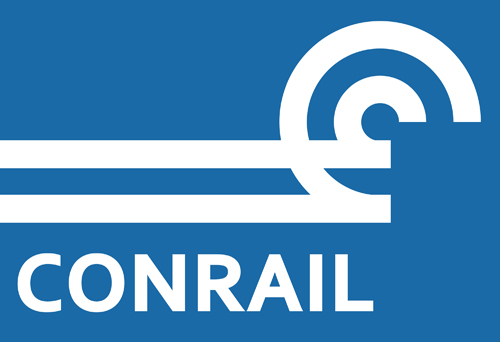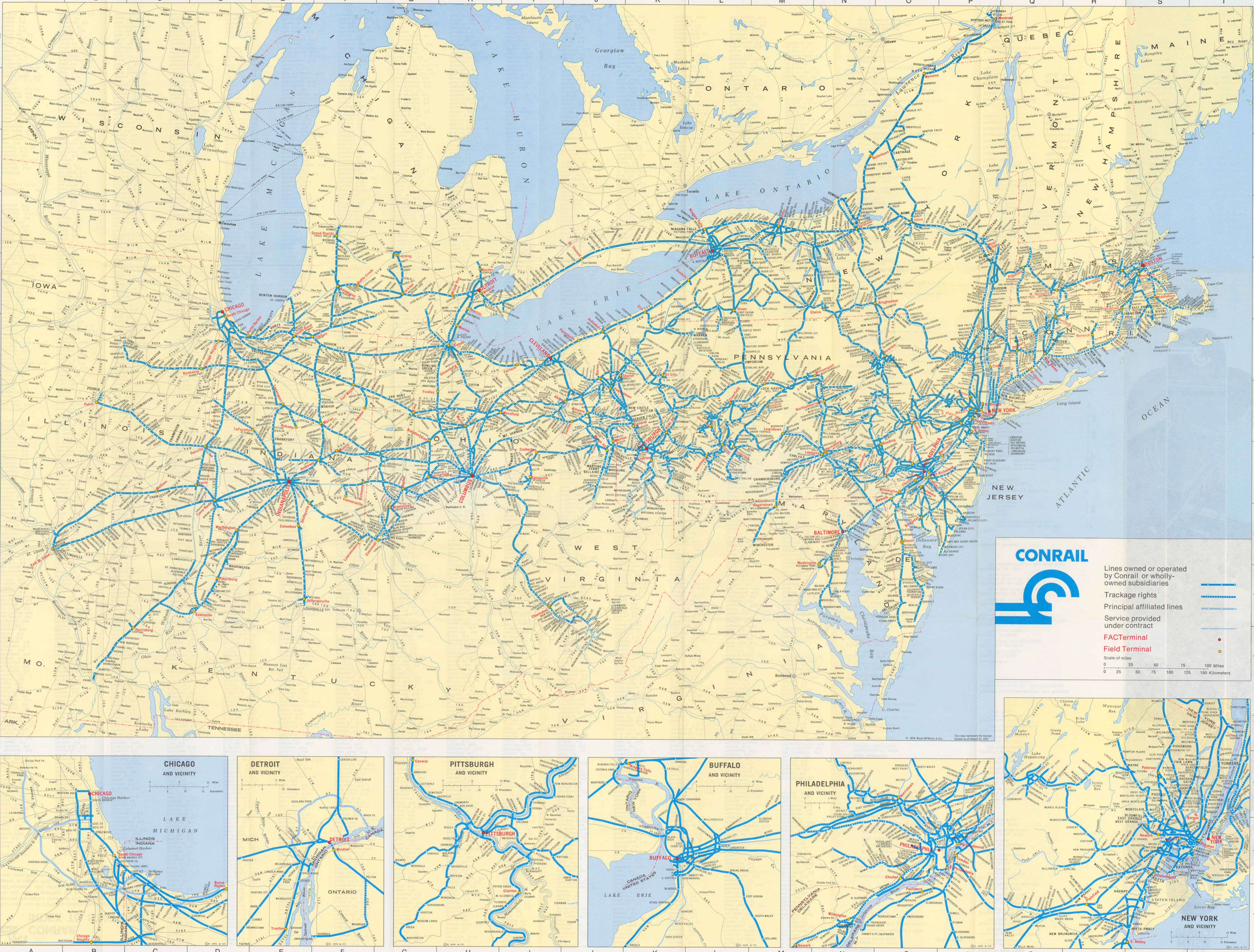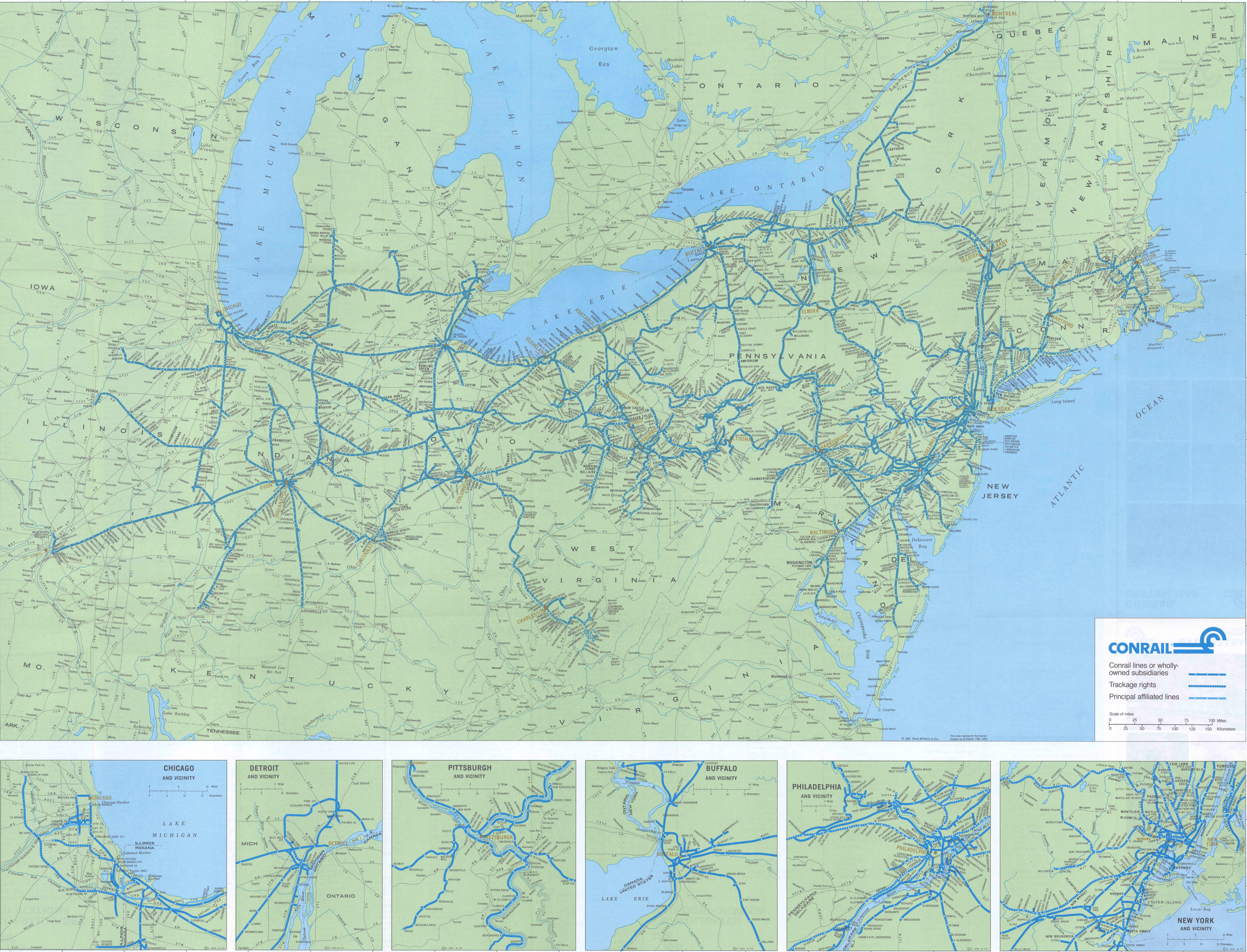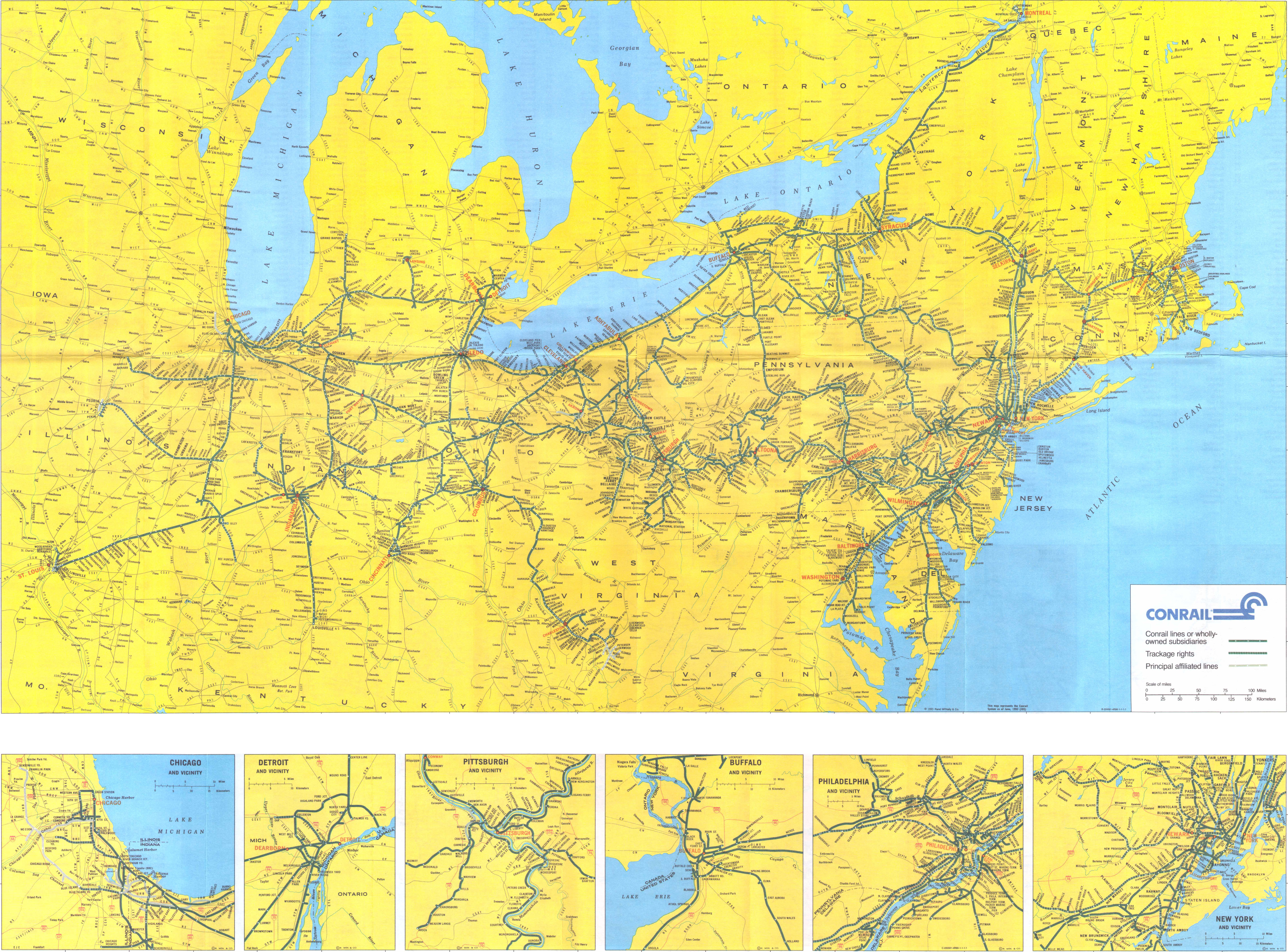- Home ›
- Fallen Flags ›
- Conrail
Conrail (Railroad): Map, Logo, Roster, History
Last revised: August 22, 2024
By: Adam Burns
The Consolidated Rail Corporation, better known as Conrail, was government’s answer to the Northeastern rail industry's collapse during the 1970s.
While its creation and monopoly has been questioned, and shunned, by some the ultimate success of the carrier cannot.
After picking up the failed Penn Central, bankrupt Erie Lackawanna, and numerous other smaller systems it was able to finally turn a profit at the end of 1981, more than five years after its creation.
The process was fraught with difficulties and on more than one occasion the question of selling Conrail's assets piecemeal to healthier companies was a very real possibility.
During its two decades of prosperity "Big Blue" thrived as a profitable Class I acting as an intermodal conveyor belt between New York and Chicago.
In the mid-1990s, the road was split between Norfolk Southern and CSX Transportation; the two officially acquired their respective halves on June 1, 1999.
Photos
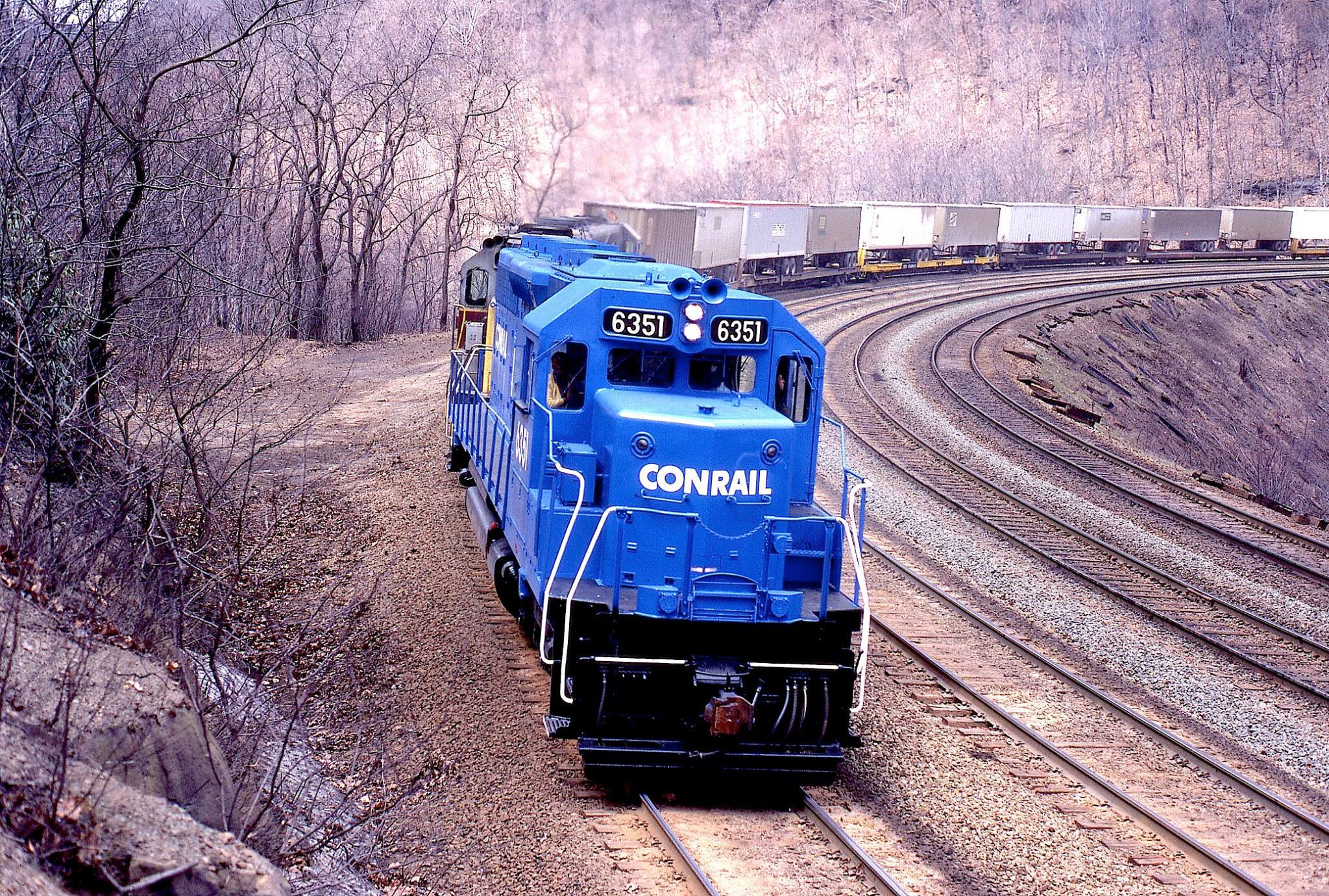 Recently repainted Conrail SD40 #6351 (built as Pennsylvania #6098) grinds upgrade with westbound vans on the famous Horseshoe Curve. Note that at the date of this photo all four tracks were still in service. Warren Calloway photo.
Recently repainted Conrail SD40 #6351 (built as Pennsylvania #6098) grinds upgrade with westbound vans on the famous Horseshoe Curve. Note that at the date of this photo all four tracks were still in service. Warren Calloway photo.History
To understand how Conrail was formed one must look back at the Northeastern railroad market of the 1970s. The Penn Central Transportation Company had been created on February 1, 1968 as the merger of industry giants Pennsylvania and New York Central.
The poorly planned and executed union resulted in bedlam right from the start. The railroad was devouring over $1 million a day and trains were lost throughout the system as classification clerks struggled to properly dispatch cars amid a disorganized routing system.
As the strain of cash shortfalls tightened deferred maintenance became the norm with large sections of its network reduced to 10 mph slow orders while freight snarled to a crawl.
At A Glance
19,000 (1976) 10,826 (1998) |
|
After Penn Central failed, entering bankruptcy on June 21, 1970, the other major Northeastern railroads soon followed.
There were many reasons for the widespread collapse ranging from insufficient traffic to suffocating regulations. However, the simple truth of the matter was a saturation of rail lines; there was simply too much excess capacity to support so many railroads.
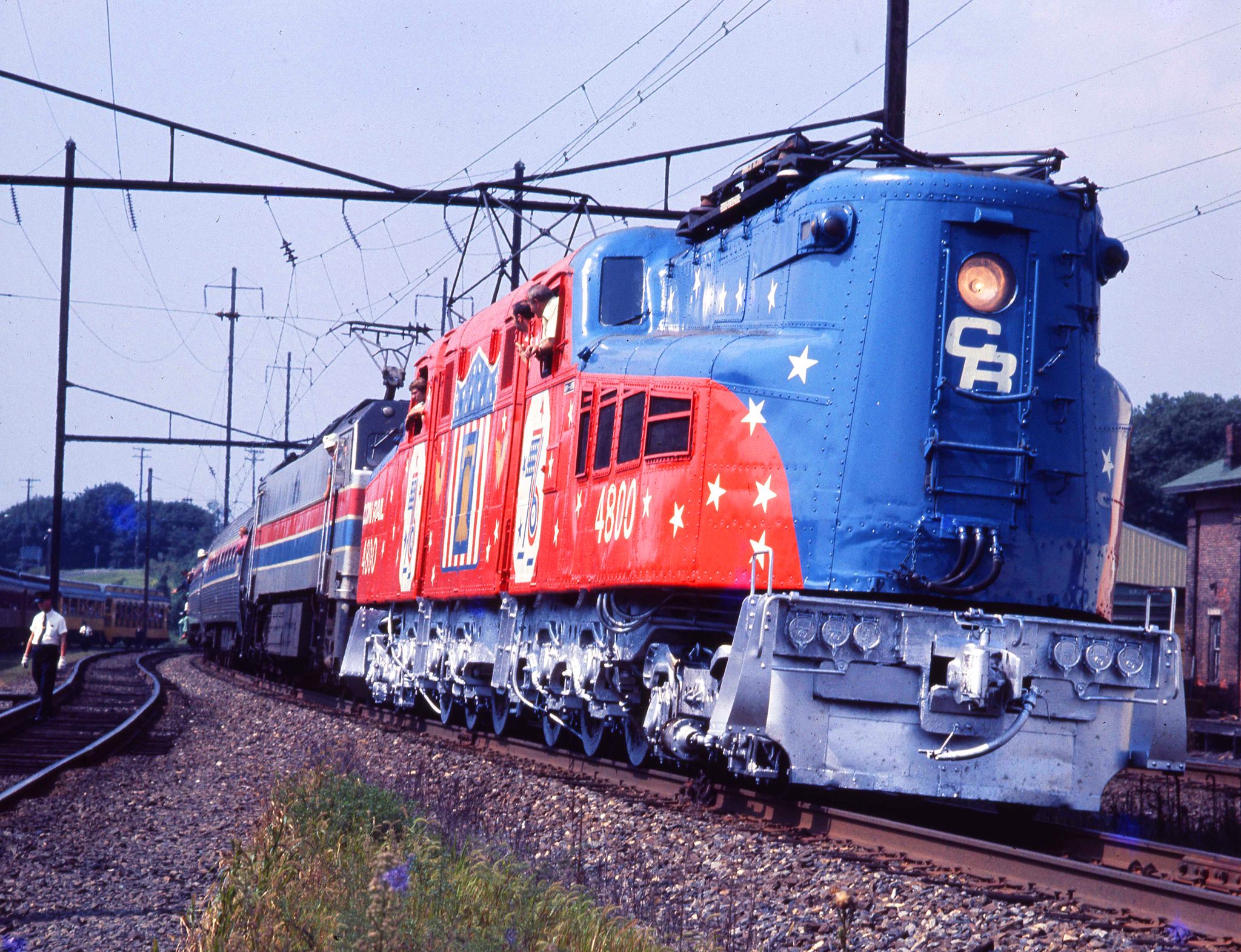 Conrail GG-1 #4800 ("Old Rivets," the original GG-1), in its Bicentennial livery, is stopped at Leaman Place, Pennsylvania - interchange with the Strasburg Railroad - ahead of an Amtrak special in the summer of 1976. Jerry Custer photo.
Conrail GG-1 #4800 ("Old Rivets," the original GG-1), in its Bicentennial livery, is stopped at Leaman Place, Pennsylvania - interchange with the Strasburg Railroad - ahead of an Amtrak special in the summer of 1976. Jerry Custer photo.Creation
Following Penn Central's demise John P. Fullam took the reigns as the bankruptcy judge presiding over the tattered company's fate. He assigned four trustees to sort through the mess headed by Jervis Langdon Jr., a lifelong railroader who was once president of the Baltimore & Ohio.
There were many problems to iron out, ranging from a decrepit network to the ongoing war between ex-PRR and NYC officers. Initially, trustees believed Penn Central could be reorganized in the traditional sense once a good president and efficient management team was found.
Alas, the issues proved far more complex than any of them realized. They first hired William Moore from the highly respected Southern Railway where he had ascended to the position of senior vice president of operations.
The Southern was a disciplined, well-oiled machine. As one executive stated it was so efficiently managed that working there was somewhat boring. Ultimately, though, Moore was too overbearing for the job and fired. Ironically, Langdon, himself, wound up at the helm in January of 1973.
Logo
There were many things Penn Central required, ranging from regulation relief to emergency loans. This meant governmental involvement. Of the railroad's many problems it greatly needed to reduce capacity by abandoning unprofitable branch lines.
Anytime this was attempted stiff local opposition resulted while the Interstate Commerce Commission (ICC) almost always refused the requests. According to Rush Loving, Jr.'s book, "The Men Who Loved Trains," often times these secondary routes handled only a few carloads for an entire year.
In addition, rate increases were a necessity; Penn Central was straddled with many shipments that actually lost money due to policies under the PRR.
Once again, however, the ICC declined the appeals. Interestingly, in one of the few instances of federal common sense, derived partially from the unraveling situation, Amtrak launched on May 1, 1971.
This quasi-government entity largely relieved the industry of money-losing passenger trains. Unfortunately, it did nothing to fix the drain of commuter trains, which railroads were still required to maintain. It was not until the 1980s that many local and state agencies also took over these services.
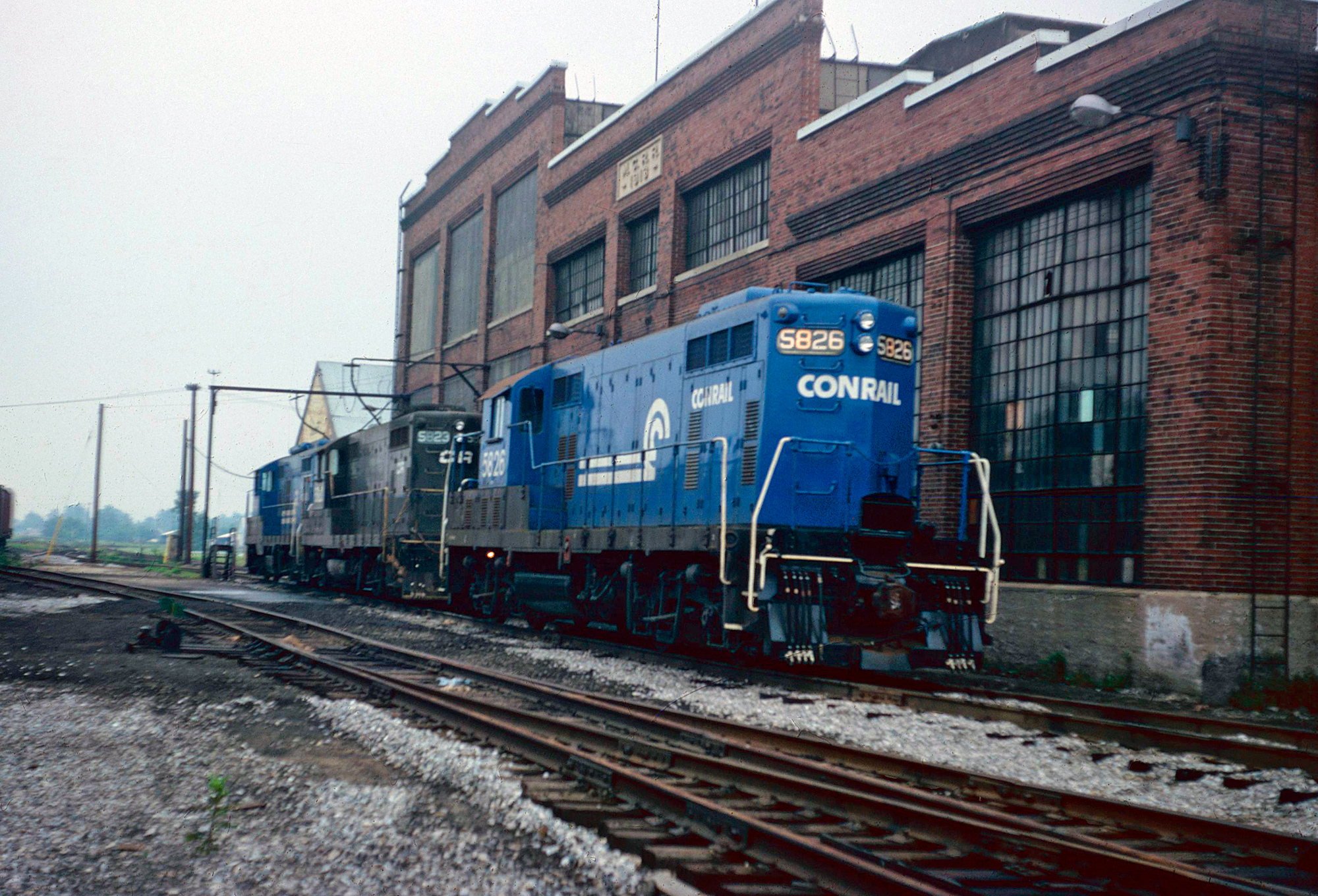 A pair of Conrail GP7's, #5826 and #5823, and a GP9, layover at the former Michigan Central (New York Central) shops in St. Thomas, Ontario during August of 1977. American-Rails.com collection.
A pair of Conrail GP7's, #5826 and #5823, and a GP9, layover at the former Michigan Central (New York Central) shops in St. Thomas, Ontario during August of 1977. American-Rails.com collection.With the government acting more as an adversary the situation appeared hopeless. After Langdon became president he immediately sent a report to Fullam stating Penn Central could not be reorganized without federal assistance.
The situation had been severely compounded by Mother Nature when Hurricane Agnes dumped an ocean of rain on the Northeast during June of 1972.
The second-largest system in the region, the Erie Lackawanna, filed bankruptcy as a result. The storm caused upwards of $11 million in damages to its network.
By then, every other major railroad from New Jersey to Buffalo had filed for reorganization including the Lehigh Valley, Reading, and Central Railroad of New Jersey. The situation was untenable. Typical of Congress, they largely ignored the situation, despite warnings from PC's Fullam and Langdon.
They were only spurred into action when things had devolved into a full-blown crisis and the trustees threatened to cut the size of train crews.
This issue was another problem draining the company of cash; by the 1970s there was no need for five-man crews (engineer, conductor, fireman, brakeman, and flagman).
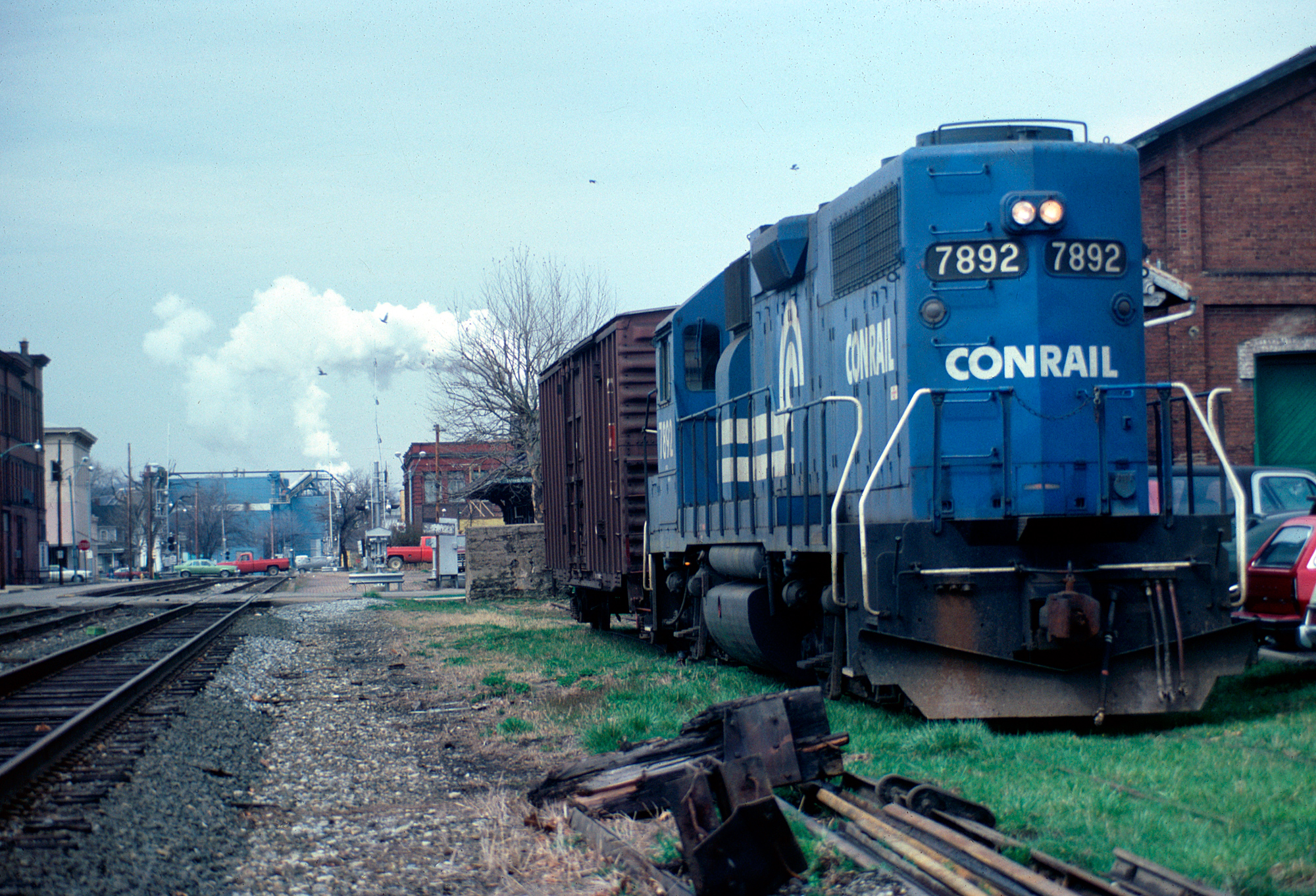 Conrail GP38 #7892 picks up a load from Shaw-Barton at the freight depot in downtown Coshocton, Ohio on April 13, 1983. American-Rails.com collection.
Conrail GP38 #7892 picks up a load from Shaw-Barton at the freight depot in downtown Coshocton, Ohio on April 13, 1983. American-Rails.com collection.It was another holdover from the days of steam locomotives. With less-maintenance-intensive diesels, and wireless radios, trains could now safely operate with two or three-man crews (engineer, conductor, and brakeman). Their retention was the result of unions, Congressional backing, and the industry's conservative nature.
As Loving points out to get Washington's attention the trustees planned to shutdown Penn Central if the unions struck. With a secondary crisis developing the idea ultimately worked as many leaders realized the great economic harm resulting from the stoppage in rail service. On February 7, 1973 the unions actually did walk out, but only briefly.
Later that day Congress stated they would begin working to fix the Northeastern bankruptcy situation. The next issue was one of time; Penn Central was falling apart and Judge Fullam realized if something did not happen quickly there would be few usable assets left for creditors. In another words, liquidation was imminent.
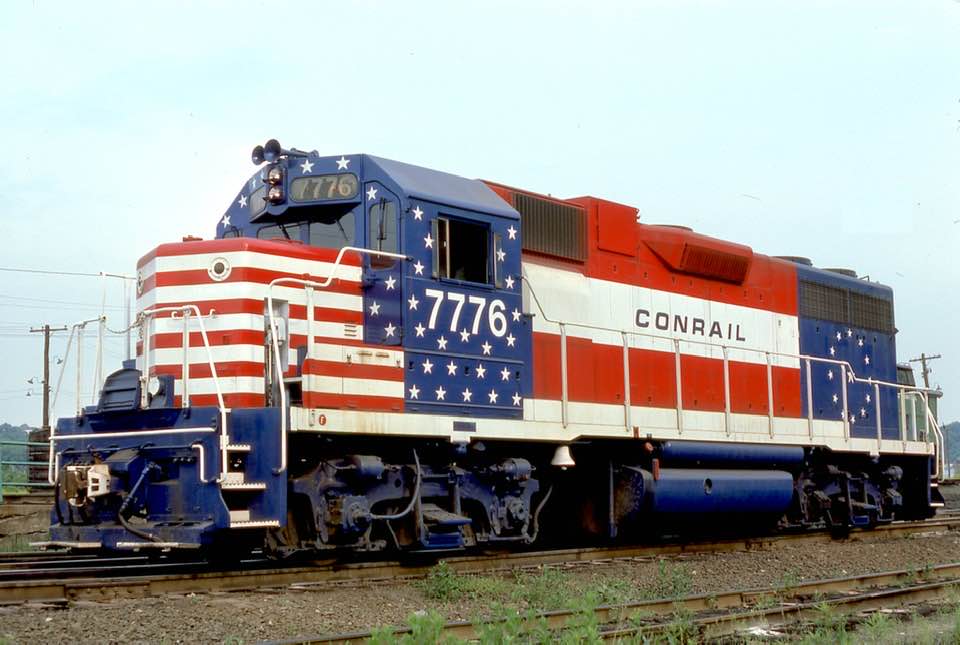 Conrail GP38 #7776 (built as Penn Central #7776) is dressed in a Bicentennial livery circa 1976. Warren Calloway collection.
Conrail GP38 #7776 (built as Penn Central #7776) is dressed in a Bicentennial livery circa 1976. Warren Calloway collection.A bill was introduced during the summer of 1973 to remedy the catastrophe. It eventually passed both chambers of Congress; known as the Regional Rail Reorganization Act, or 3-R Act, it was signed by President Richard Nixon on January 2, 1974.
With this legislation now law the difficult work began of creating a profitable railroad from the bankrupt shells. Piecing together what became the Consolidated Rail Corporation involved three different entities:
- The United States Railway Administration (operating under the auspices of the Department of Transportation)
- The Rail Services Planning Office (an agency which would oversee and evaluate USRA ideas).
- The railroad arm itself (Conrail).
The USRA was tasked with actually creating the system and its final network. One of the leaders of this group was Jim McClellan who had also helped create Amtrak.
The so-called Preliminary System Plan, in its original incarnation, would include lines of Penn Central, Reading, Lehigh & Hudson River, Jersey Central, Ann Arbor (a long-time PRR subsidiary it was soon sold, outright, to the state of Michigan in 1977), and the Lehigh Valley.
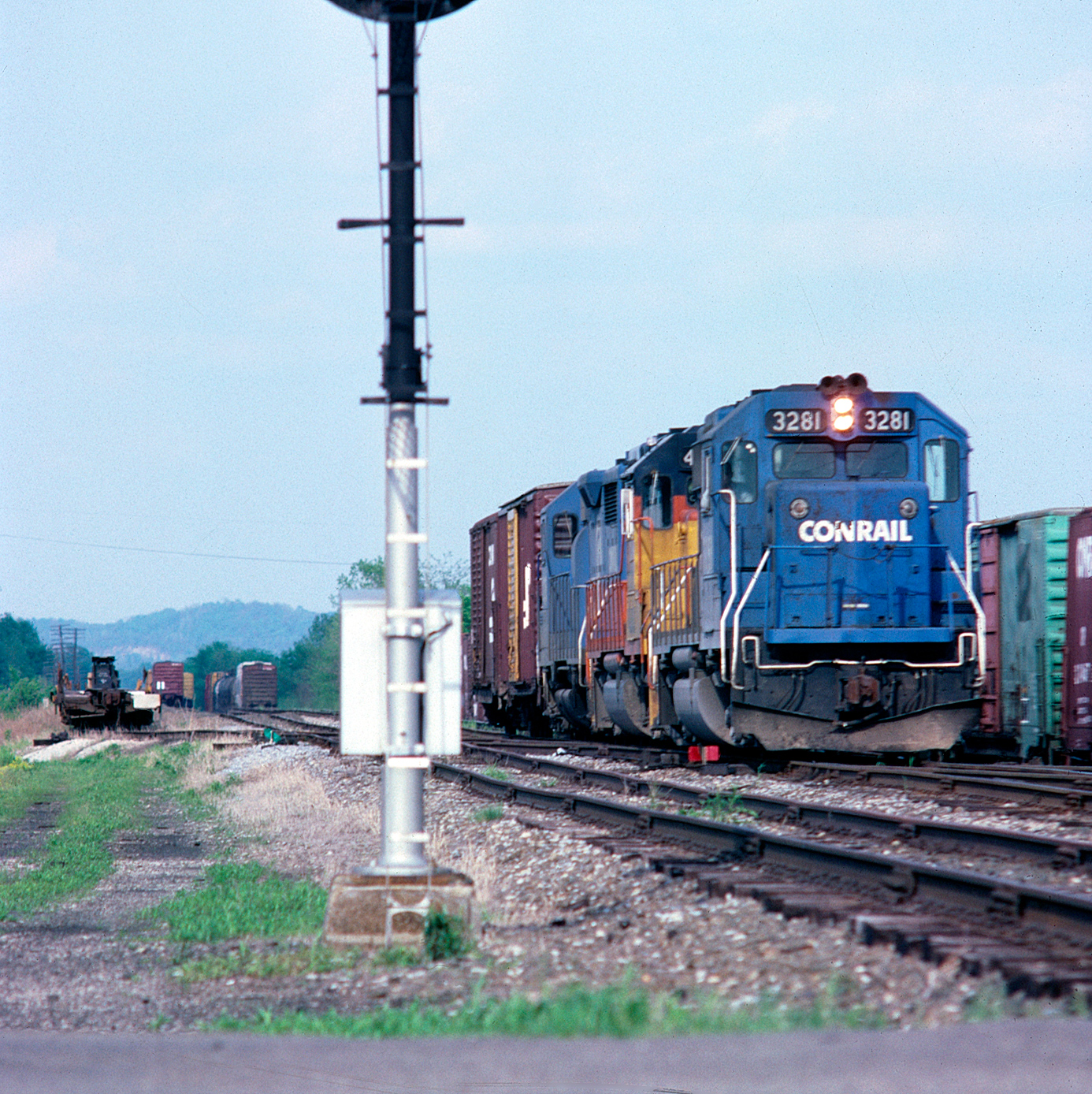 Conrail GP40-2 #3281 and other power working local service; May, 1983. Location not recorded but likely somewhere in Ohio on the former PRR. American-Rails.com collection.
Conrail GP40-2 #3281 and other power working local service; May, 1983. Location not recorded but likely somewhere in Ohio on the former PRR. American-Rails.com collection.There was initially no thought of including Erie Lackawanna. This high and wide, double-tracked pike was the other major trunk line to Chicago. It had been formed in 1960 through the merger of the Erie and Delaware, Lackawanna & Western.
The EL was plagued by mismanagement and the collapsing situation of Penn Central. Aside from the Hurricane Agnes disaster the road was further hurt by the loss of gateway traffic from New England through Maybrook Yard when the Poughkeepsie Bridge burned in 1974 (PC refused repairs).
System Map (1978)
According to H. Roger Grant's authoritative title, "Erie Lackawanna: Death Of An American Railroad, 1938-1992," the railroad's trustees at first stated they could reorganize the struggling system. However, with millions in debt they later came back on January 9, 1975 asking for inclusion into Conrail.
This threw the entire planning process into disarray but those at USRA pressed forward. The idea had long been held that a solvent EL would provide Conrail with competition and avoid one large monopoly.
System Map (1986)
To bolster this effort, one plan called for the CNJ, Reading, LV, and L&HR to be combined into MARC, the Mid-Atlantic Railroad. The new system would then work with EL to compete against Conrail. Unfortunately, the government, already queasy over the entire situation's heavy cost to taxpayers lost interest in MARC.
Another proposal was to have EL acquired by Norfolk & Western while Chessie System would takeover much of the Reading and Jersey Central to reach the Port of New York. The latter was referred to as the "Three Systems East" plan.
System Map (1993)
It was the brainchild of Jim McClellan and assistant Gerald Davies. Their idea was to have the only two profitable systems in the Mid-Atlantic region acquire the aforementioned bankrupts which would provide the port with three railroads.
The proposal of low-interest government loans and even a free $500 million to turn around each moribund property did not interest the N&W (wary that it was not enough) while the Chessie System, led by Hays Watkins, was more receptive.
With the N&W backpedaling, Chessie was offered the Erie Lackawanna during July of 1975, which became known as the "Two Systems East" plan.
Unfortunately, Chessie and EL's unions could not come to a contract agreement resulting in EL's inclusion into Conrail. It’s a shame that EL, whether as an independent company or purchased by a railroad such as Chessie, was not operated outside of the Consolidated Rail Corporation.
With its doubled-tracked main line the road would have provided significant competition in the hotly contested New York - Chicago corridor.
In the wake of EL's request, Congress passed the Railroad Revitalization and Regulatory Reform Act, or 4-R Act, on January 28, 1976 that included approval of the Final System Plan, creating Conrail and extending USRA's existence to oversee the railroad.
It also aided in restricting the ICC from meddling in the road's affairs. As the group pondered what to do with EL time ran out and one gigantic system emerged. Its start date was set for April 1, 1976.
Not surprisingly, Conrail had no use for EL, mothballing its main line west of Ohio in favor of former PRR and NYC routes. Today, the Friendly Service Route is gone in the Midwest.
Consolidated Rail Corporation
McClellan had argued that more than 15,575 route miles needed immediately cut, excluding EL's lines (3,000 miles). This was well over half the network.
Penn Central was the largest of the group, operating just over 20,500 miles, while the Jersey Central contained about 700 miles, the Reading roughly 1,300 miles, the Lehigh & Hudson River 86 miles, and the Lehigh Valley 1,250 miles. Including EL, the figure totaled more than 26,800 miles.
Interestingly, during the PC's dying days Langdon had also made a similar statement that nearly 50% of the railroad should be abandoned since only 11,000 miles contained 80% of its freight revenues. At the time his words were mostly ignored by the ICC. Ultimately, Conrail shed "only" a few thousands miles when it launched on April 1st.
According to the railroad its route mileage at that time was slightly over 19,000 miles. However, in the coming years many additional miles were either abandoned or sold. The reductions continued through the 1990s. By 1998 it contained just 10,826 route miles.
One of Conrail's lasting legacies was deregulation. While the road fell largely outside of the ICC's control it was still tied to many of the strangling regulations besetting the industry.
As Loving points out nothing magical happened in the beginning. It continued to lose roughly $1 million a day, just like Penn Central.
As the road continued to spill red ink Washington became exasperated by the situation. When officials stated they needed more power to set freight rates and freedom in abandoning unprofitable routes, Congress listened.
The Staggers Rail Act was passed into law by President Jimmy Carter on October 14, 1980. It was named for Harley Staggers, a U.S. Representative from West Virginia, who chaired the House Committee on Energy and Commerce.
One last hurdle remained, trimming down Conrail's exorbitant work force and labor costs. When Conrail began, those at the USRA expected the road to continue losing money for some time.
However, by 1980 there appeared no end to the losses. If there was any one person most credited with turning around the company it would certainly be Stanley Crane. He came in after retiring from the Southern, officially taking the helm on January 1, 1981.
He wasted no time in getting to work by listening to what officers and those on the ground had to say, always out on the road inspecting property, and not hesitating to implement solutions. Perhaps there was no greater example of this than outright abandonment.
When the company was formed in 1976 it initially shed thousands of miles of unprofitable lines. Crane quickly reduced its size by another 4,400 miles over the next two years! Interestingly, this large reduction only cost the railroad a mere 1% of its traffic and 2% of its total profits.
Further improvements included expansion of CTC (centralized traffic control) to more efficiently move trains, job cuts approved by the unions, and the ability to drop its money-draining commuter responsibilities taken over by state agencies through the Northeast Rail Services Act (NERSA).
Profitability
By the end of 1981 Conrail was finally in the black and turning a profit for the first time since the early days of Penn Central in 1968, over thirteen years earlier!
Even more impressive is that planners at the USRA expected Conrail to carry "...a negative cash flow until at least 1990" (from the article "Kneiling vs. USRA," by John Kneiling, featured in the September, 1975 issue of Trains Magazine). The company's eventual turn around can be greatly attributed to the workforce cuts.
Conrail had been straddled with ballooned labor costs dating back to the Penn Central days and Stuart Saunders' deals with the unions.
Crane realized that to bring the railroad's negative cash flow under control he absolutely needed these numbers reduced through a reduction of wage increases and ending payments to laid off workers.
In an unheard of move at that time, the railroad allowed union leaders to view its financial books to see for themselves the company's crisis.
It worked, and labor agreed to the cuts. Loving notes when profits began to grow larger and larger some senior officers did not want to return the wage increases;
"...But Crane believed the workers had saved Conrail by giving up the $200 million. 'You give that money back,' he ordered. 'We're making money. They helped us. Don't forget that.'"
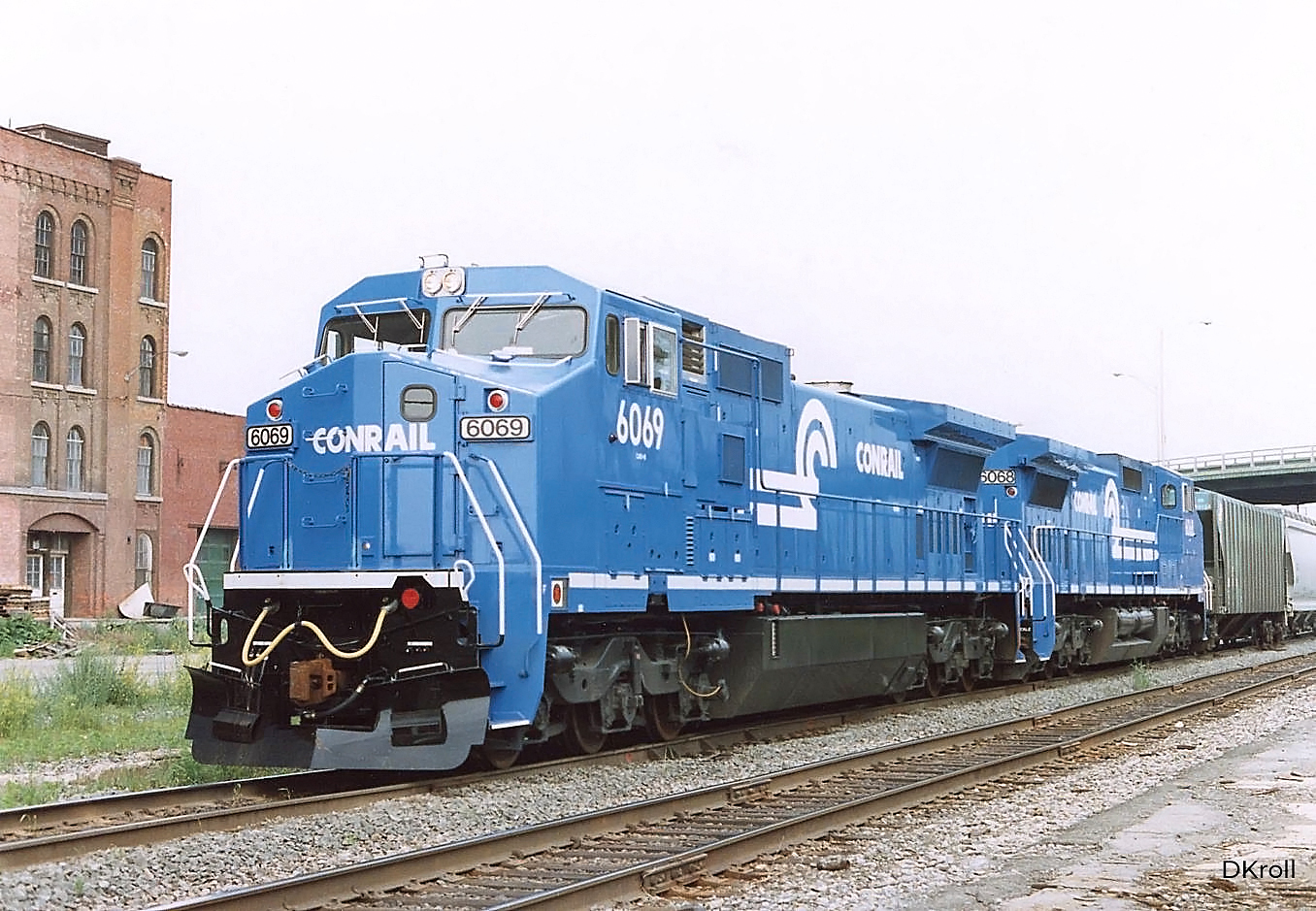 Recently delivered Conrail C40-8Ws #6069 and #6068 are on westbound train OIBU at Binghamton, New York on June 16, 1990. Doug Kroll photo.
Recently delivered Conrail C40-8Ws #6069 and #6068 are on westbound train OIBU at Binghamton, New York on June 16, 1990. Doug Kroll photo.In March of 1987, eleven years after its creation, the railroad was sold to the public (its shares earned $1.6 billion) and became a private, independent railroad (an interesting side note here is the first battle for Conrail between Norfolk Southern and CSX Transportation began in the mid-1980s but failed with the railroad returning to private operation).
Diesel Roster
American Locomotive Company
| Model Type | Road Number | Date Built | Quantity |
|---|---|---|---|
| MT-4 | 1000-1023 (Former PRR RS11s, converted as slugs.) | 1957 | 24 |
| MT-6 | 1100-1128 (Former PRR RSD12s and RSD15s, converted as slugs.) | 1955-1958 | 29 |
Electro-Motive Division
| Model Type | Road Number | Date Built | Quantity |
|---|---|---|---|
| GP15-1 | 1600-1699 | 1979 | 100 |
| SD70 | 2557-2580 | 1998 | 24 |
| GP40-2 | 3275-3403 | 1973-1980 | 129 |
| E8A | 4020-4022 (Ex-PRR/Erie) | 1951-1952 | 3 |
| SD80MAC | 4100-4129 | 1996-1997 | 30 |
| SD70MAC | 4130-4144 | 1998 | 15 |
| SD60M | 5500-5574 | 1993 | 75 |
| SD60I | 5575-5654 | 1994-1995 | 80 |
| SD40-2 | 6358-6524, 6960-6999 (Rebuilt PRR SD40s) | 1977-1979 | 207 |
| SD45-2 | 6654-6666 (Ex-EL) | 1972 | 13 |
| SD50 | 6700-6834 | 1983-1986 | 135 |
| SD60 | 6840-6867 | 1984-1989 | 28 |
| SD38 | 6925-6959 (Ex-PC) | 1970 | 35 |
| GP38 | 7600-7939 (Some Ex-LV/PRSL/PC) | 1965-1971 | 340 |
| GP38-2 (Some Ex-PC) | 8040-8281 | 1972-1979 | 242 |
| SW1001 | 9400-9424 (Ex-Reading) | 1973 | 25 |
| SW1500 | 9500-9620 (Ex-IU/LV/PC/Reading) | 1966-1973 | 121 |
General Electric
| Model Type | Road Number | Date Built | Quantity |
|---|---|---|---|
| 80-Tonner | 99 | (Ex-Housatonic) | 1 |
| C40-8W | 700-759 | 1994 | 60 |
| B23-7/R | 1900-2023, 2030-2040, 2800-2816 | 1972-1979 | 152 |
| B36-7 | 5000-5059 | 1983 | 60 |
| B40-8 | 5060-5089 | 1988 | 30 |
| C39-8 | 6000-6021 | 1986 | 22 |
| C40-8/W | 6025-6265 | 1989-1994 | 241 |
| C30-7a | 6550-6599 | 1984 | 50 |
| C32-8 | 6610-6619 | 1984 | 10 |
| C36-7 | 6620-6644 | 1985 | 25 |
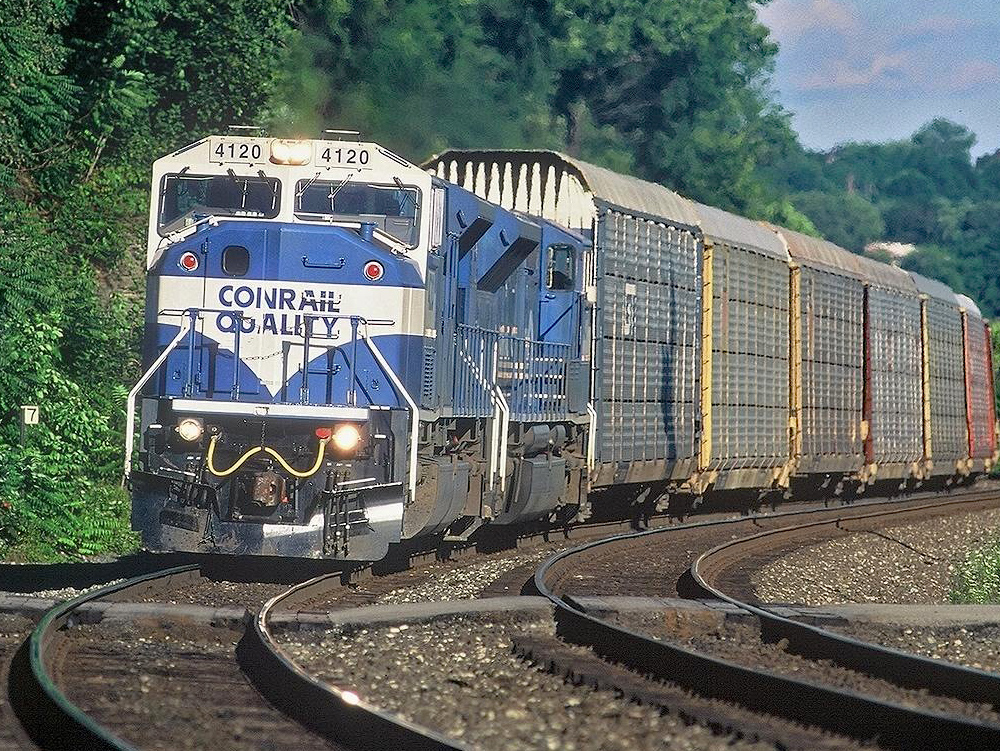 Some of the last new locomotives Conrail acquired included its fleet of SD80MAC's. Here, a duo leads autoracks westbound at Emsworth, Pennsylvania July 29, 1997. Wade Massie photo.
Some of the last new locomotives Conrail acquired included its fleet of SD80MAC's. Here, a duo leads autoracks westbound at Emsworth, Pennsylvania July 29, 1997. Wade Massie photo.CSX-Norfolk Southern Acquisition
What would truly make the company profitable was the intermodal revolution. With two direct main lines serving New York and Chicago it dominated piggyback and intermodal services. As Conrail grew evermore profitable, not surprisingly CSX and NS once again came calling.
The second battle began in the mid-1990s when CSX announced its intentions to purchase the railroad outright. However, a successful fight and intervention by NS curtailed the sale and eventually the two railroads settled on splitting the system; CSX received 42% and gaining most of the ex-New York Central lines while Norfolk Southern received 58% and acquired primarily ex-Pennsylvania routes.
Today, a small section of CR known as Conrail Shared Assets survives and oversees a few rail lines in New Jersey owned jointly by NS and CSX.
For more reading on the railroad, its creation, years of operation, and ultimate sale to Norfolk Southern and CSX I strongly recommend "The Men Who Loved Trains: The Story of Men Who Battled Greed to Save an Ailing Industry," from Rush Loving, Jr.
The book is one of my personal favorites and Loving provides a detailed look at management and operations (and their fundamental problems and flaws) while also keeping things very interesting and not just a boring textbook filled with dull numbers and procedures (the book was also given high marks by the leading industry magazine, Trains from Kalmbach Publishing).
The book will also give you a bit of understanding about how the current eastern road’s fate came about through failed mergers and other attempts that were unsuccessful.

